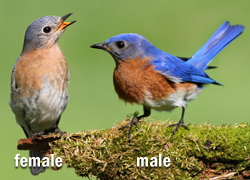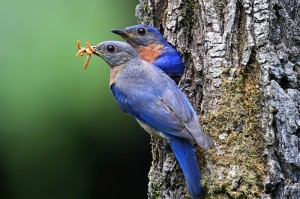 Identification
Identification
This 7″-long bird has bright blue head, back and tail with a rust-colored breast and white under belly. The female is similar, with a slightly grayer blue on the tail and wings.
Habitat and Nesting
Eastern Bluebirds prefer mixed hardwood forests and grasslands, including meadows, prairies and pastures plus human-made grasslands like cemeteries and golf courses.
Bluebirds typically migrate to southern states in the winter, but some will overwinter in Minnesota, returning in March. They nest beginning in mid- to late April, building cup-shaped nests in existing cavities, including nest boxes. Females incubate 4–5 pale blue eggs for 12–14 days. Male and female Eastern Bluebirds feed their fledglings. Learn about attracting bluebirds and placing a nest box in your yard.
 Diet
Diet
Eastern Bluebirds are primarily insectivores, ingesting spiders, live and dried mealworms, millipedes, caterpillars and other delectable lawn bugs. It is vital to the ongoing health of the bluebird population to provide a pesticide- or chemical-free yard.
During the early spring and late fall, when insects are less plentiful, the bluebirds will dine on sumac seeds and honeysuckle, as well as several types of berries and grapes. They also have been attracted to feeders using nut meats, suet and raisins.
All Seasons Wild Bird Store offers several types of dish-like bluebird feeders, and in our stores we sell the mealworms to use in them.
Want to learn more?
For more information on the Eastern Bluebird, visit the North American Bluebird Society.

